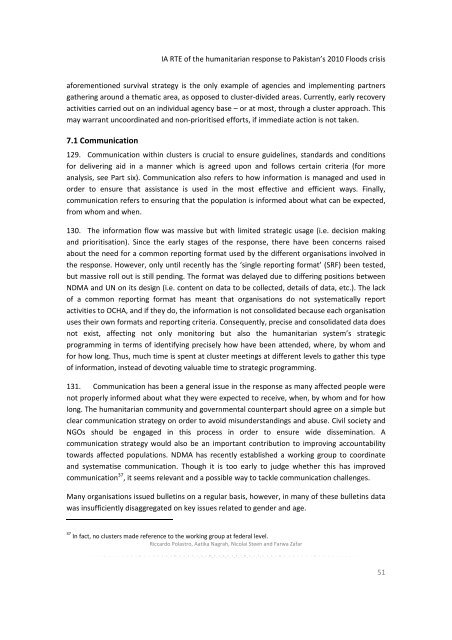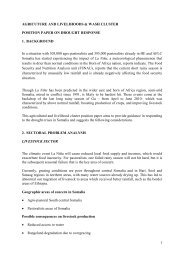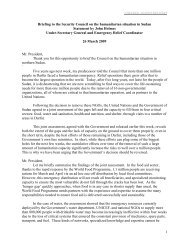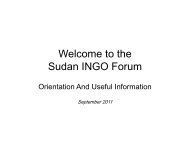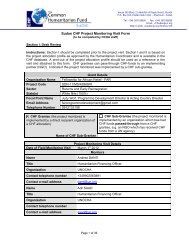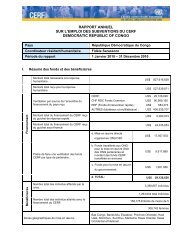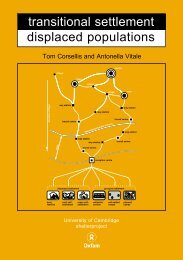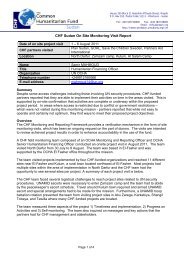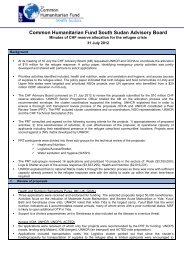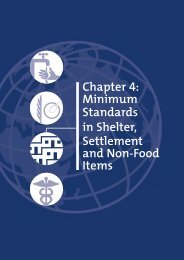Inter-Agency Real Time Evaluation of the Humanitarian ... - OCHANet
Inter-Agency Real Time Evaluation of the Humanitarian ... - OCHANet
Inter-Agency Real Time Evaluation of the Humanitarian ... - OCHANet
Create successful ePaper yourself
Turn your PDF publications into a flip-book with our unique Google optimized e-Paper software.
IA RTE <strong>of</strong> <strong>the</strong> humanitarian response to Pakistan’s 2010 Floods crisis<br />
aforementioned survival strategy is <strong>the</strong> only example <strong>of</strong> agencies and implementing partners<br />
ga<strong>the</strong>ring around a <strong>the</strong>matic area, as opposed to cluster‐divided areas. Currently, early recovery<br />
activities carried out on an individual agency base – or at most, through a cluster approach. This<br />
may warrant uncoordinated and non‐prioritised efforts, if immediate action is not taken.<br />
7.1 Communication<br />
129. Communication within clusters is crucial to ensure guidelines, standards and conditions<br />
for delivering aid in a manner which is agreed upon and follows certain criteria (for more<br />
analysis, see Part six). Communication also refers to how information is managed and used in<br />
order to ensure that assistance is used in <strong>the</strong> most effective and efficient ways. Finally,<br />
communication refers to ensuring that <strong>the</strong> population is informed about what can be expected,<br />
from whom and when.<br />
130. The information flow was massive but with limited strategic usage (i.e. decision making<br />
and prioritisation). Since <strong>the</strong> early stages <strong>of</strong> <strong>the</strong> response, <strong>the</strong>re have been concerns raised<br />
about <strong>the</strong> need for a common reporting format used by <strong>the</strong> different organisations involved in<br />
<strong>the</strong> response. However, only until recently has <strong>the</strong> ‘single reporting format’ (SRF) been tested,<br />
but massive roll out is still pending. The format was delayed due to differing positions between<br />
NDMA and UN on its design (i.e. content on data to be collected, details <strong>of</strong> data, etc.). The lack<br />
<strong>of</strong> a common reporting format has meant that organisations do not systematically report<br />
activities to OCHA, and if <strong>the</strong>y do, <strong>the</strong> information is not consolidated because each organisation<br />
uses <strong>the</strong>ir own formats and reporting criteria. Consequently, precise and consolidated data does<br />
not exist, affecting not only monitoring but also <strong>the</strong> humanitarian system’s strategic<br />
programming in terms <strong>of</strong> identifying precisely how have been attended, where, by whom and<br />
for how long. Thus, much time is spent at cluster meetings at different levels to ga<strong>the</strong>r this type<br />
<strong>of</strong> information, instead <strong>of</strong> devoting valuable time to strategic programming.<br />
131. Communication has been a general issue in <strong>the</strong> response as many affected people were<br />
not properly informed about what <strong>the</strong>y were expected to receive, when, by whom and for how<br />
long. The humanitarian community and governmental counterpart should agree on a simple but<br />
clear communication strategy on order to avoid misunderstandings and abuse. Civil society and<br />
NGOs should be engaged in this process in order to ensure wide dissemination. A<br />
communication strategy would also be an important contribution to improving accountability<br />
towards affected populations. NDMA has recently established a working group to coordinate<br />
and systematise communication. Though it is too early to judge whe<strong>the</strong>r this has improved<br />
communication 37 , it seems relevant and a possible way to tackle communication challenges.<br />
Many organisations issued bulletins on a regular basis, however, in many <strong>of</strong> <strong>the</strong>se bulletins data<br />
was insufficiently disaggregated on key issues related to gender and age.<br />
37<br />
In fact, no clusters made reference to <strong>the</strong> working group at federal level.<br />
Riccardo Polastro, Aatika Nagrah, Nicolai Steen and Farwa Zafar<br />
51


